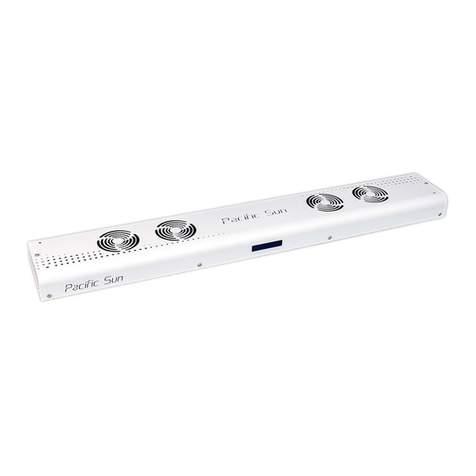So funktionieren die Calciumreaktoren
Es ist sehr wichtig, genügend Calcium und Alkalinität im Riffbecken zu halten. Beide Parameter können durch
wachsende Organismen, die diese Verbindungen aufnehmen, schnell verändert werden. Um die Wasserparame-
ter auf einem angemessenen Niveau zu halten, sollten diese Mikroelemente ergänzt werden.
Ein Calciumreaktor ist der einfachste und genaueste Weg, um Calcium und
Alkalinität im Becken zu erhalten.
Der Calciumreaktor löst kleine Mengen von festem Calciumcarbonat in eine flüssige Form,
die in einen Behälter dosiert wird. Die dem Behälter zugegebene konzentrierte Flüssigkeit enthält das richtige
Calcium/Alkali-Verhältnis,
das für das richtige chemische Gleichgewicht des Wassers unerlässlich ist. Im Gegensatz zu den meisten Was-
serdosierergänzungen sollte ein gut funktionierender Calciumreaktor langfristig das richtige Gleichgewicht zwi-
schen Calcium und Alkalinität aufrechterhalten.
Der Reaktor ist mit Calciumcarbonat-Hinterfüllung (z.B. Riffsand, Schalen, gebrauchsfertige Medien, wie ARM
von Caribea, usw.) und Salzwasser gefüllt. Wir empfehlen Korngrößen ab 6 mm, da dies für einen besseren Dur-
chfluss sorgt und
ein teilweises Zerkleinern des Granulats am Boden
des Reaktors verhindert.
Eine kleine Menge Kohlendioxid wird dem Wasser im Reaktor zugegeben, wodurch der pH-Wert
auf 6,5 bis 6,8 gesenkt wird. Bei einem so niedrigen pH-Wert beginnt sich das Calciumcarbonat-Hinterfüllung
aufzulösen und setzt Calcium- und Alkaliionen frei, so dass sie in das Aquarium dosiert werden können.
Diese Lösung ist sehr konzentriert, so dass nur eine geringe Menge an Sickerflüssigkeit für die Dosierung in den
Becken benötigt wird.
Im Laufe der Zeit werden sowohl Calciumcarbonat, als auch Kohlendioxid-Hinterfüllung verwendet.
Der Verbrauch hängt vom Kalziumbedarf Ihres Aquariums ab, aber in den meisten Fällen kann davon ausgegan-
gen werden, dass der Reaktor mehrere Monate ohne größere Wartung laufen wird.
Es ist wichtig, die Durchflussrate von CO2 (gemessen in Blasen pro Minute), das in den Calciumreaktor gelangt,
regelmäßig zu überprüfen. Es ist auch sehr wichtig, regelmäßig Calcium- und Alkalinitätswerte mit einem zu-
verlässigen Test zu messen und, falls erforderlich, den Sickerwasserfluss am Calkfeederregler zu korrigieren.
Zulässiger Calcium- und Alkalinitätsbereich
2,5-4,0 meq / l (7-11 dKH) Alkalinität und 375-450 ppm Calcium
Nicht fortsetzen, wenn die Ergebnisse nicht in diesem Bereich liegen!
Vorbereitung der Anlage zur Inbetriebnahme
1. Die Deckel der beiden Reaktorsäulen entfernen.
2. Füllen Sie die Calcium-Hinterfüllung in die Hauptsäule des Reaktors (erst nach dem Spülen).
3. Gießen Sie volles Wasser über die CO2-Mischsäule (um alle Luft zu entfernen) und schließen Sie dann den
Deckel der Mischsäule (mit Bioball-Einsatz). Ziehen Sie die Schrauben fest an, ziehen Sie die Schrauben abwech-
selnd gegenläufig an, so dass der Schließdruck gleichmäßig verteilt wird).
4. Anschließend, gießen Sie die Calciumbettsäule mit Wasser, bis die Spitze der Reaktionssäule erreicht ist.
5. Schließen Sie die Reaktionssäule fest und ziehen Sie die Schrauben abwechselnd wieder an.
6. Schließen Sie den Reaktorcontroller - CalcFeeder PRO an. Schließen Sie das Magnetventil vorerst nicht an.
7. Lassen Sie die Dosierpumpe mit einer Leistung von ca. 5l/h laufen - so gießt die Pumpe Wasser in den Reaktor
und entfernt die restliche Luft unter der Abschaltung der Hauptsäule des Reaktors.
8. Schalten Sie die Hauptpumpe (weiß, am Boden des Reaktors befestigt) ein - das Wasser wird im Reaktorkre-
islauf zirkulieren.
Ihr Reaktor ist nun bereit für den Anschluss der Steuerung und des Zubehörs, wie die CO2-Flasche und das
Magnetventil.
Schließen Sie das Magnetventil an die CO2-Flasche an (ausgestattet mit einem Manometer und einem präzisen
CO2-Abflaufssregler). Wir empfehlen, den Flaschendruck so einzustellen, dass 6-10 Blasen CO2-Gas pro Se-
kunde am Reglerausgang zugeführt werden.
Nach der Einstellung des richtigen Gasdrucks schließen Sie das CO2-Magnetventil (im Lieferumfang des Reak-
tors enthalten) an und vergewissern Sie sich, dass es richtig angeschlossen ist (ein kleiner Pfeil auf dem Magne-
tventilgehäuse zeigt den korrekten Gasfluss vom Zylinder zum Reaktor an).
Vergewissern Sie sich, dass die Anschlüsse fest sitzen, ziehen Sie sie gegebenenfalls fest an, ohne sie jedoch
mit zu viel Kraft zu beschädigen.
Seite 6






























